Effect of TRC and F/TRC Strengthening on the Cracking Behaviour of RC Beams in Bending
Abstract
:1. Introduction
2. Materials and Methods
2.1. Geometry and Test Setup
2.2. Material Characteristics and Strengthening Solutions
3. Results
3.1. Load Carrying Capacity and Failure Modes
- (a)
- rupture of the textile fabric;
- (b)
- pull-out of the longitudinal strands from the cementitious matrix;
- (c)
- debonding of the TRC of F/TRC element signalled by the presence of a long horizontal crack at the interface with the NSC;
- (d)
- interlaminar shearing, where a horizontal crack formed along the textile fabric within the strengthening layer;
- (e)
- peeling of the concrete cover, when the debonding of the strengthening element did not happen at the interface between the two materials but inside the NSC, approximately at the height of the longitudinal reinforcing bars.
3.2. Damage Evolution and Crack Patterns
Number of Cracks
4. Discussion
4.1. Number of Cracks at the Reference Loads
4.2. Maximum and Average Crack Opening at the Reference Loads
5. Conclusions
- Strengthening reinforced concrete beams with TRC or F/TRC materials proved to be an effective and viable solution, not only for retrofitting, but also for a reduction in damage and crack opening control, thus increasing their performance.
- Each strengthening solution resulted in an increase in the cracking load (between 8.3% and 127.1%), depending on the number of textile layers, cementitious matrix, and type and arrangement of mechanical anchorages.
- The combination of short dispersed steel fibres and mechanical anchorage devices has the highest potential in increasing the cracking load (between 59.7% and 77.9%) associated with very small cracks (0.1 mm).
- The use of fine-grain HPC in combination with textile reinforcement proved to outperform UHPFRC in terms of cracking load increase, number of large cracks and ability to reduce both the maximum and average crack opening.
- Bonded anchors, used as end anchorage of the strengthening TRC and F/TRC layer, were very effective in preventing the formation of larger cracks and in reducing both the maximum and average crack opening. They also provided the best performance increase in terms of cracking load and the number of cracks at low load levels only when they were combined with short dispersed steel fibres. Furthermore, all beams strengthened with bonded anchors were able to achieve the highest gain in maximum strength compared to beams without those anchoring elements.
Author Contributions
Funding
Institutional Review Board Statement
Informed Consent Statement
Data Availability Statement
Acknowledgments
Conflicts of Interest
References
- American Society of Civil Engineers. Report Card for America’s Infrastructure; American Society of Civil Engineers: Reston, VA, USA, 2013. [Google Scholar]
- Bell, B.; Network Rail. European Railway Bridge Demography. 2004. Technical Report Number: WP1-02-T-040531-R-Deliverable D 1.2. Available online: http://bridgeforum.org/files/pub/2006/sustainable-bridges/WP1-02-T-040531-R-Deliverable%20D%201.2.pdf (accessed on 29 July 2021).
- Bundesministerium Für Verkehr und Digitale Infrastruktur (German Federal Ministry of Transport and Digital Infrastructure), Stand der Modernisierung von Straßenbrücken der Bundesfernstraßen 2018. Available online: https://www.bmvi.de/SharedDocs/DE/Anlage/StB/bericht-stand-der-modernisierung-von-strassenbruecken-2018.pdf?__blob=publicationFile (accessed on 29 July 2021).
- Awani, O.; El-Maaddawy, T.; Ismail, N. Fabric-Reinforced Cementitious Matrix: A Promising Strengthening Technique for Concrete Structures. Constr. Build. Mater. 2017, 132, 94–111. [Google Scholar] [CrossRef]
- Nobili, A.; Falope, F.O. Impregnated Carbon Fabric-Reinforced Cementitious Matrix Composite for Rehabilitation of the Finale Emilia Hospital Roofs: Case Study. J. Compos. Constr. 2017, 21, 05017001. [Google Scholar] [CrossRef] [Green Version]
- Bencardino, F.; Carloni, C.; Condello, A.; Focacci, F.; Napoli, A.; Realfonzo, R. Flexural Behaviour of RC Members Strengthened with FRCM: State-of-the-Art and Predictive Formulas. Compos. Part B Eng. 2018, 148, 132–148. [Google Scholar] [CrossRef]
- Koutas, L.N.; Tetta, Z.; Bournas, D.A.; Triantafillou, T.C. Strengthening of Concrete Structures with Textile Reinforced Mortars: State-of-the-Art Review. J. Compos. Constr. 2019, 23, 03118001. [Google Scholar] [CrossRef]
- Tarque, N.; Salsavilca, J.; Yacila, J.; Camata, G. Multi-Criteria Analysis of Five Reinforcement Options for Peruvian Confined Masonry Walls. Earthq. Struct. 2019, 17, 205–219. [Google Scholar] [CrossRef]
- Wakjira, T.G.; Ebead, U. Experimental and Analytical Study on Strengthening of Reinforced Concrete T-Beams in Shear Using Steel Reinforced Grout (SRG). Compos. Part B Eng. 2019, 177, 107368. [Google Scholar] [CrossRef]
- Salsavilca, J.; Yacila, J.; Tarque, N.; Camata, G. Experimental and Analytical Bond Behaviour of Masonry Strengthened with Steel Reinforced Grout (SRG). Constr. Build. Mater. 2020, 238, 117635. [Google Scholar] [CrossRef]
- Funari, M.F.; Verre, S. The Effectiveness of the DIC as a Measurement System in SRG Shear Strengthened Reinforced Concrete Beams. Crystals 2021, 11, 265. [Google Scholar] [CrossRef]
- Li, B.; Xiong, H.; Jiang, J.; Dou, X. Tensile Behavior of Basalt Textile Grid Reinforced Engineering Cementitious Composite. Compos. Part B Eng. 2019, 156, 185–200. [Google Scholar] [CrossRef]
- Deng, M.; Dong, Z.; Zhang, C. Experimental Investigation on Tensile Behavior of Carbon Textile Reinforced Mortar (TRM) Added with Short Polyvinyl Alcohol (PVA) Fibers. Constr. Build. Mater. 2020, 235, 117801. [Google Scholar] [CrossRef]
- Dong, Z.; Deng, M.; Zhang, C.; Zhang, Y.; Sun, H. Tensile Behavior of Glass Textile Reinforced Mortar (TRM) Added with Short PVA Fibers. Constr. Build. Mater. 2020, 260, 119897. [Google Scholar] [CrossRef]
- Li, T.; Deng, M.; Dong, Z.; Zhang, Y.; Zhang, C. Masonry Columns Confined with Glass Textile-Reinforced High Ductile Concrete (TRHDC) Jacket. Eng. Struct. 2020, 222, 111123. [Google Scholar] [CrossRef]
- Mészöly, T.; Ofner, S.; Randl, N. Effect of Combining Fiber and Textile Reinforcement on the Flexural Behavior of UHPC Plates. Adv. Mater. Sci. Eng. 2020, 2020, 9891619. [Google Scholar] [CrossRef]
- Yang, X.; Gao, W.-Y.; Dai, J.-G.; Lu, Z.-D. Shear Strengthening of RC Beams with FRP Grid-Reinforced ECC Matrix. Compos. Struct. 2020, 241, 112120. [Google Scholar] [CrossRef]
- Zheng, Y.-Z.; Wang, W.-W.; Mosalam, K.M.; Fang, Q.; Chen, L.; Zhu, Z.-F. Experimental Investigation and Numerical Analysis of RC Beams Shear Strengthened with FRP/ECC Composite Layer. Compos. Struct. 2020, 246, 112436. [Google Scholar] [CrossRef]
- Li, T.; Deng, M.; Jin, M.; Dong, Z.; Zhang, Y. Performance of Axially Loaded Masonry Columns Confined Using Textile Reinforced Concrete (TRC) Added with Short Fibers. Constr. Build. Mater. 2021, 279, 122413. [Google Scholar] [CrossRef]
- Rossi, E.; Randl, N.; Mészöly, T.; Harsányi, P. Flexural Strengthening with Fiber-/Textile-Reinforced Concrete. ACI Struct. J. 2021, 118, 97–107. [Google Scholar] [CrossRef]
- Rossi, E.; Randl, N.; Harsányi, P.; Mészöly, T. Overlapped Joints in Textile Reinforced Concrete with UHPC Matrix: An Experimental Investigation. Mater. Struct. 2021, 54, 152. [Google Scholar] [CrossRef]
- Yin, S.; Lü, H.; Xu, S. Properties and Calculation of Normal Section Bearing Capacity of RC Flexural Beam with Skin Textile Reinforcement. J. Cent. South Univ. 2013, 20, 1731–1741. [Google Scholar] [CrossRef]
- Verbruggen, S.; Aggelis, D.G.; Tysmans, T.; Wastiels, J. Bending of Beams Externally Reinforced with TRC and CFRP Monitored by DIC and AE. Compos. Struct. 2014, 112, 113–121. [Google Scholar] [CrossRef]
- Verbruggen, S.; Tysmans, T.; Wastiels, J. TRC or CFRP Strengthening for Reinforced Concrete Beams: An Experimental Study of the Cracking Behaviour. Eng. Struct. 2014, 77, 49–56. [Google Scholar] [CrossRef]
- Verbruggen, S.; Tysmans, T.; Wastiels, J. Bending Crack Behaviour of Plain Concrete Beams Externally Reinforced with TRC. Mater. Struct. 2016, 49, 5303–5314. [Google Scholar] [CrossRef]
- Park, J.; Park, S.-K.; Hong, S. Experimental Study of Flexural Behavior of Reinforced Concrete Beam Strengthened with Prestressed Textile-Reinforced Mortar. Materials 2020, 13, 1137. [Google Scholar] [CrossRef] [Green Version]
- Mészöly, T.; Randl, N. Derivation of constitutive law for UHPFRC using DIC system. In Proceedings of the AFGC-ACI-fib-RILEM International Symposium on Ultra-High Performance Fibre-Reinforced Concrete, Montpellier, France, 2–4 October 2017; Volume 1, pp. 221–230, ISBN 978-2-35158-166-7. [Google Scholar]
- Mészöly, T.; Randl, N. An advanced approach to derive the constitutive law of UHPFRC. Archit. Civ. Eng. Environ. 2018, 11, 89–96. [Google Scholar] [CrossRef] [Green Version]
- Mészöly, T.; Randl, N. Shear Behavior of Fiber-Reinforced Ultra-High Performance Concrete Beams. Eng. Struct. 2018, 168, 119–127. [Google Scholar] [CrossRef]
- Randl, N.; Harsányi, P. Developing Optimized Strengthening Systems for Shear-Deficient Concrete Members. Struct. Concr. 2018, 19, 116–128. [Google Scholar] [CrossRef] [Green Version]
- Solidian GRID Q142/142-CCE-25 Technical Data Sheet, Version: 180703. 2018.
- Randl, N.; Steiner, T.; Ofner, S.; Baumgartner, E.; Mészöly, T. Development of UHPC Mixtures from an Ecological Point of View. Constr. Build. Mater. 2014, 67, 373–378. [Google Scholar] [CrossRef] [Green Version]
- Ricker, M.; Häusler, F.; Randl, N. Punching Strength of Flat Plates Reinforced with UHPC and Double-Headed Studs. Eng. Struct. 2017, 136, 345–354. [Google Scholar] [CrossRef]
- Deutsches Institut für Bautechnik Verfahren zur Verstärkung von Stahlbeton Mmit TUDALIT (Textilbewehrter Beton) 2016, Technical Approval Number: Z-31.10-182. Available online: https://www.irbnet.de/daten/bzp/2FF929E209/bzp-bfi_3146144.pdf (accessed on 29 July 2021).
- Graybeal, B.A. Material Property Characterization of Ultra-High Performance Concrete; Federal Highway Administration: Georgetown Pike McLean, VA, USA, 2006.
- Wang, L.; He, T.; Zhou, Y.; Tang, S.; Tan, J.; Liu, Z.; Su, J. The Influence of Fiber Type and Length on the Cracking Resistance, Durability and Pore Structure of Face Slab Concrete. Constr. Build. Mater. 2021, 282, 122706. [Google Scholar] [CrossRef]
- Wang, L.; Jin, M.; Guo, F.; Wang, Y.; Tang, S. Pore structural and fractal analysis of the influence of fly ash and silica fume on the mechanical property and abrasion resistance of concrete. Fractals 2021, 29, 2140003. [Google Scholar] [CrossRef]
- European Committee for Standardization. EN 1992-1-1, Eurocode 2: Design of Concrete Structures—Part 1-1: General Rules and Rules for Buildings; CEN: Bruxelles, Belgium, 2004. [Google Scholar]
- François, R.; Arliguie, G. Influence of Service Cracking on Reinforcement Steel Corrosion. J. Mater. Civ. Eng 1998, 10, 14–20. [Google Scholar] [CrossRef]
- Castel, A.; Vidal, T.; François, R.; Arliguie, G. Influence of Steel-Concrete Interface Quality on Reinforcement Corrosion Induced by Chlorides. Mag. Concr. Res 2003, 55, 151–159. [Google Scholar] [CrossRef]
- Michel, A.; Solgaard, A.O.S.; Pease, B.J.; Geiker, M.R.; Stang, H.; Olesen, J.F. Experimental Investigation of the Relation between Damage at the Concrete-Steel Interface and Initiation of Reinforcement Corrosion in Plain and Fibre Reinforced Concrete. Corros. Sci. 2013, 77, 308–321. [Google Scholar] [CrossRef]
- ACI Committee 224. ACI 224R-01 Conctrol of Cracking in Concrete Structures; American Concrete Institute: Farmington Hills, MI, USA, 2002; ISBN 978-0-87031-056-0. [Google Scholar]
- CEB-FIP. Fib Model Code for Concrete Structures 2010; Ernst & Sohn: Berlin, Germany, 2013. [Google Scholar] [CrossRef]
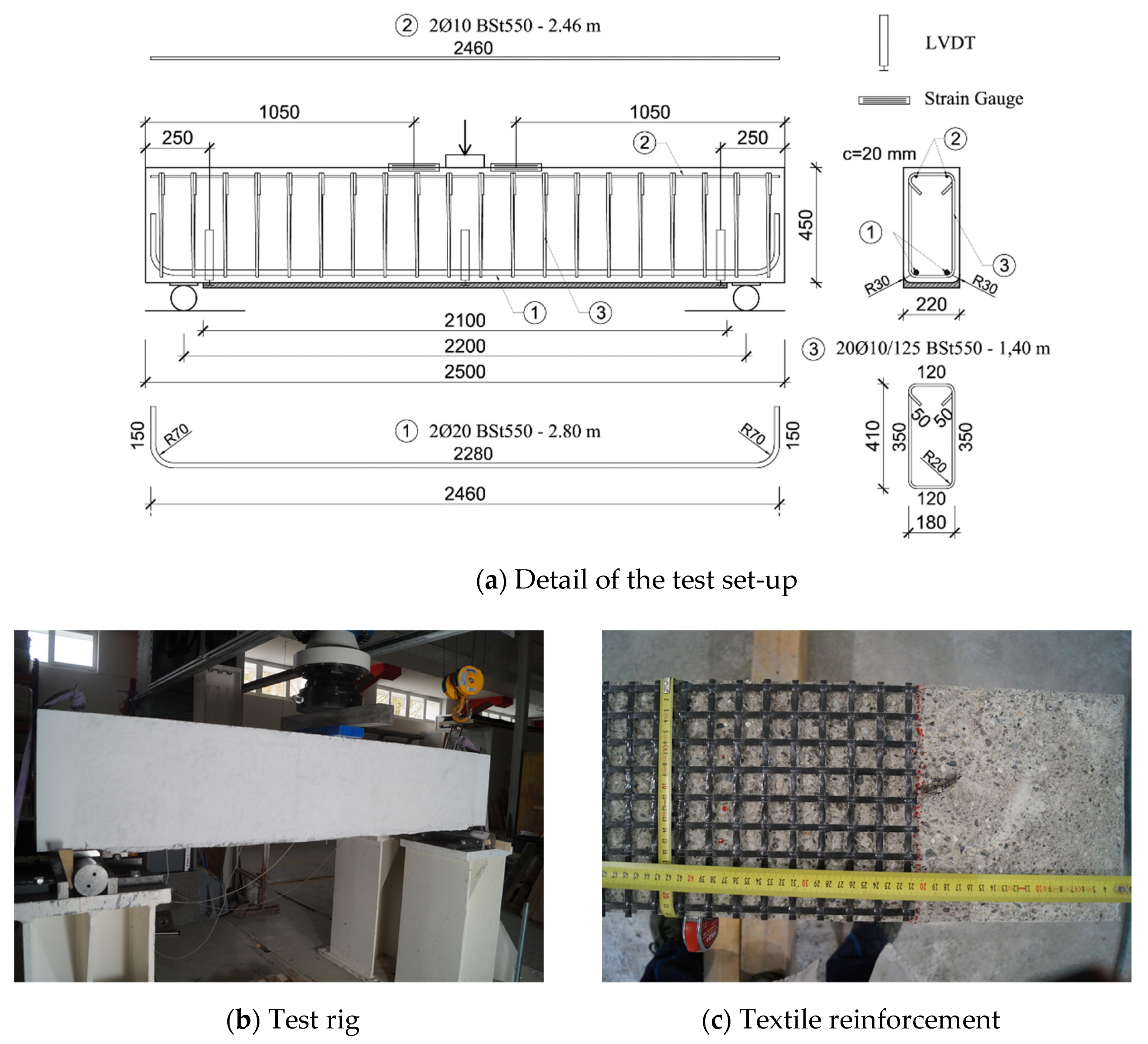
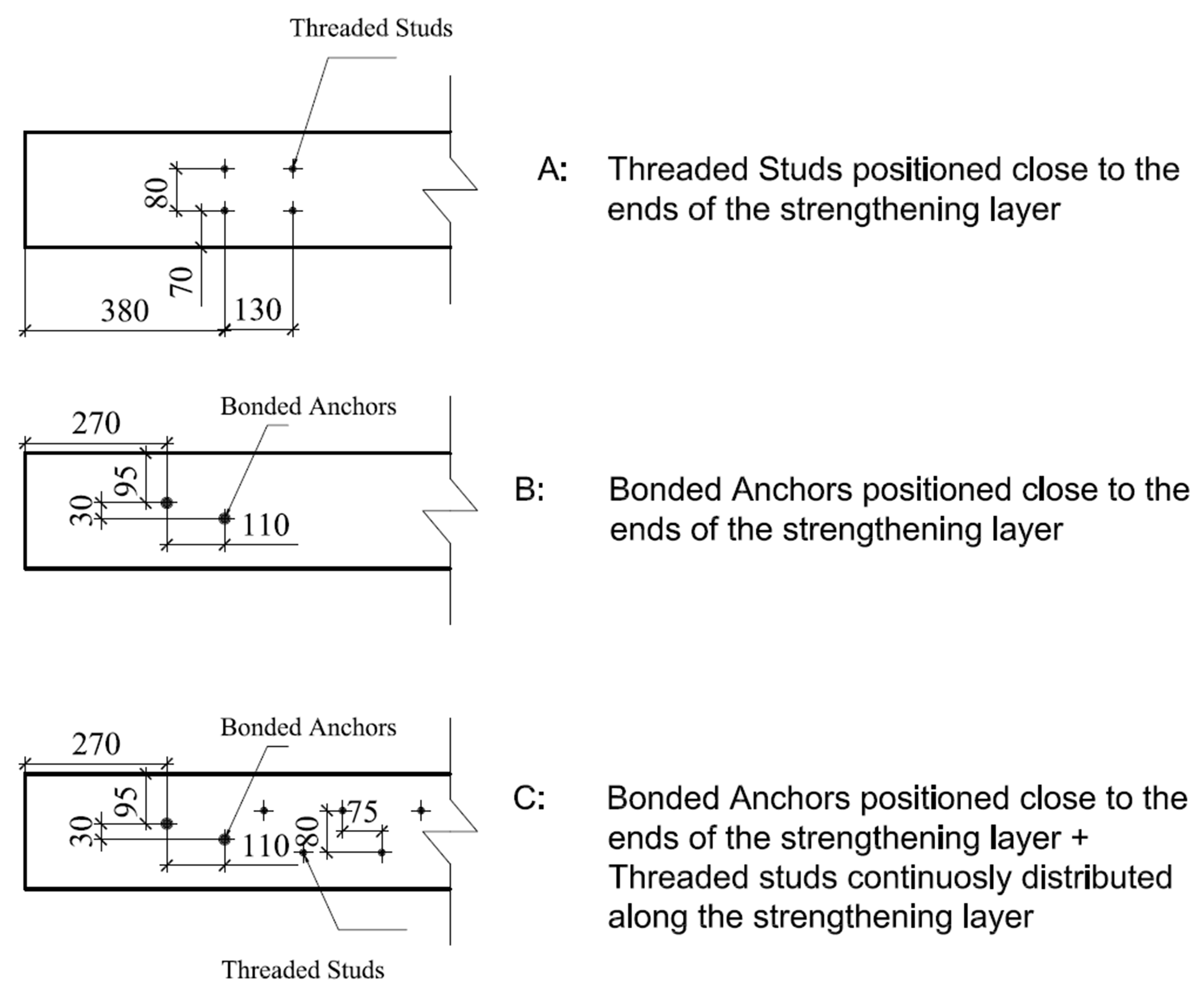
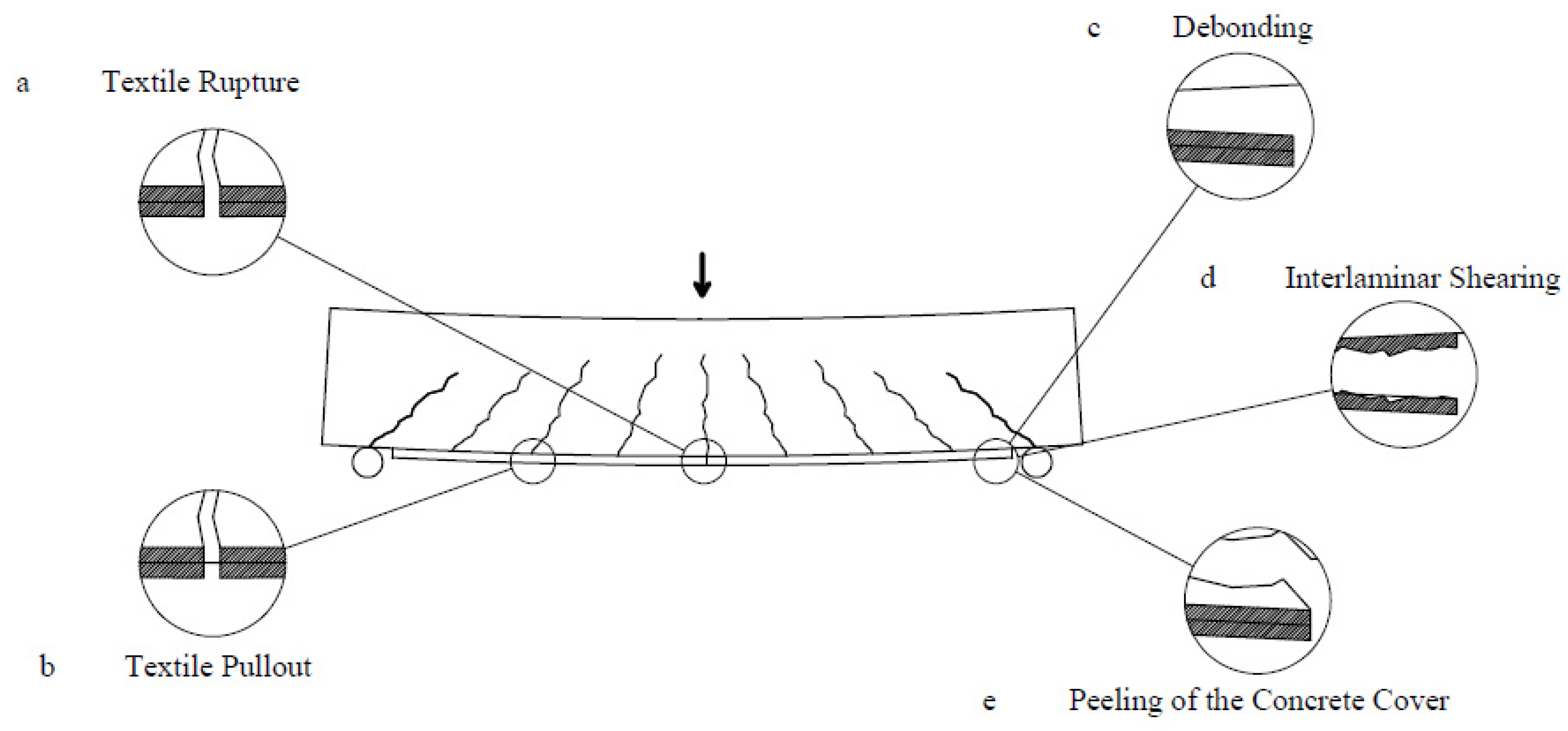
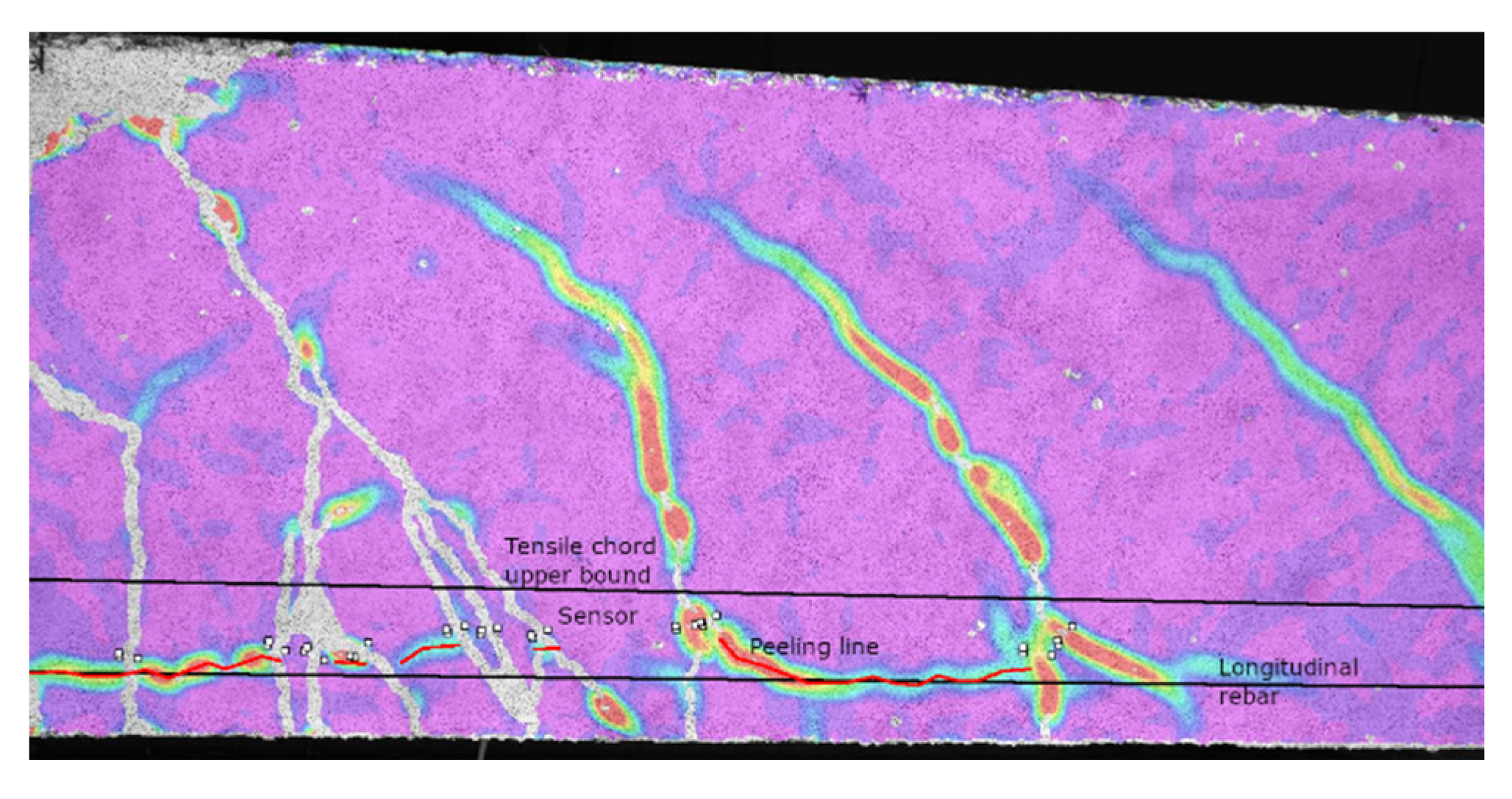

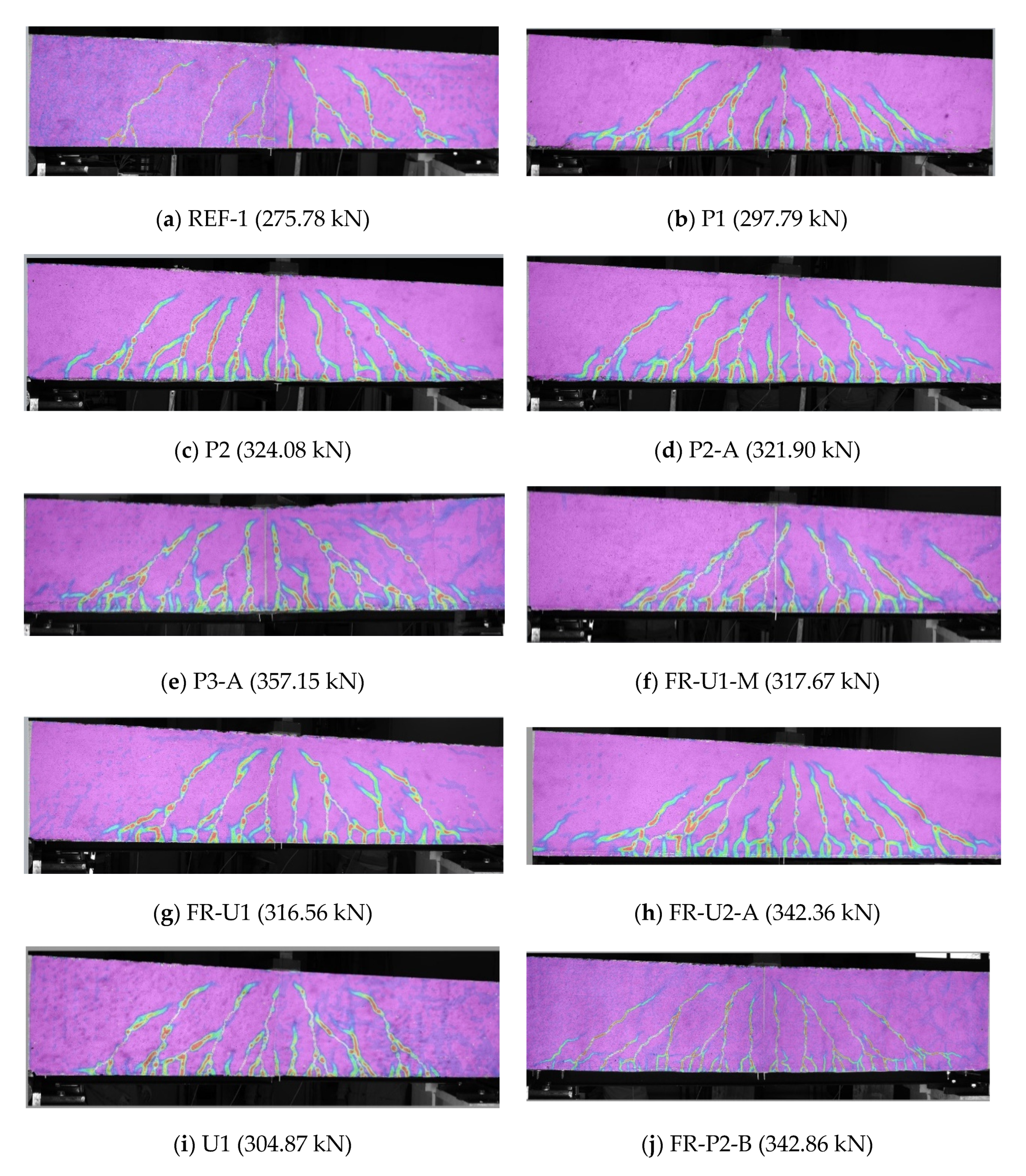

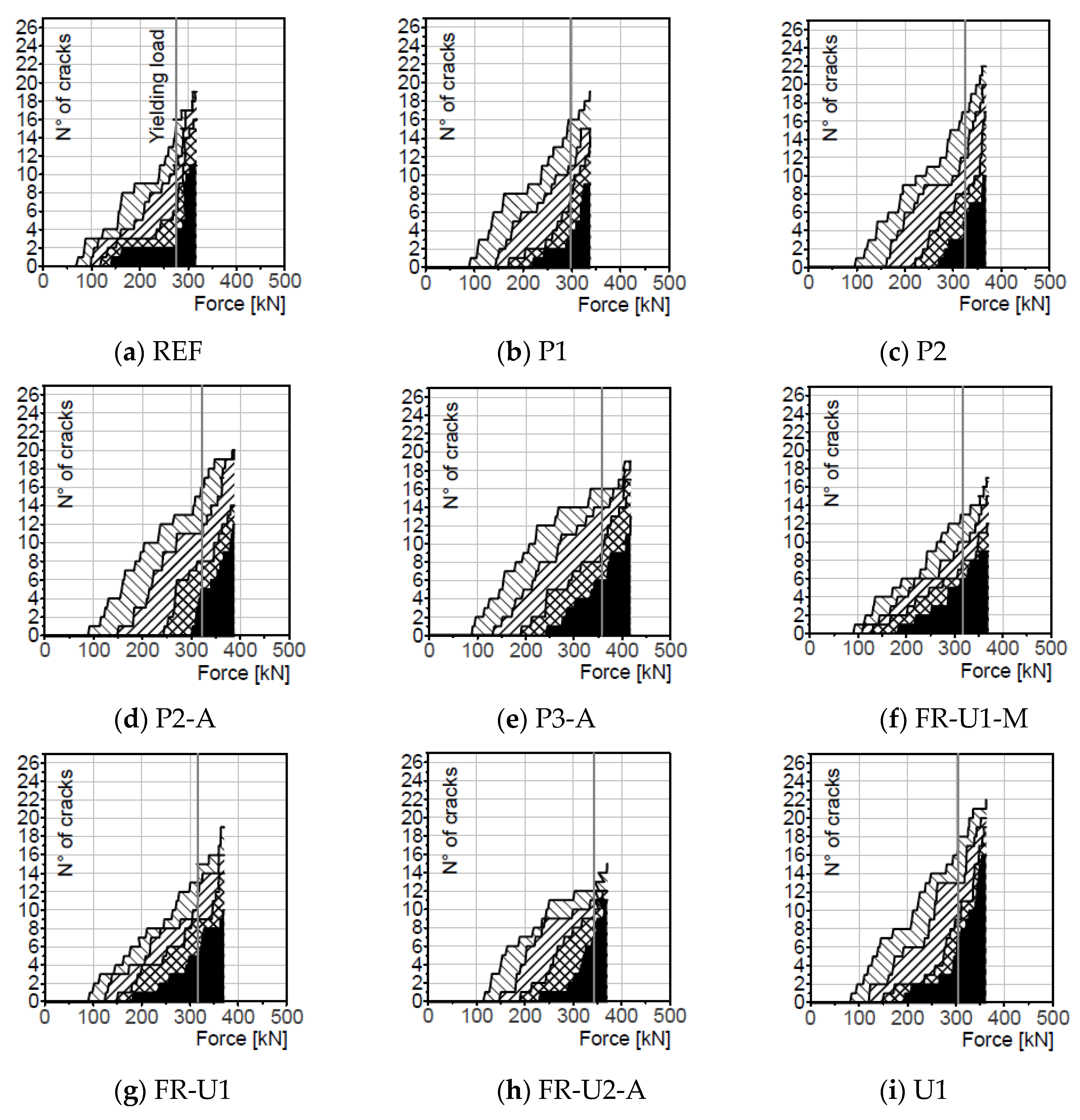
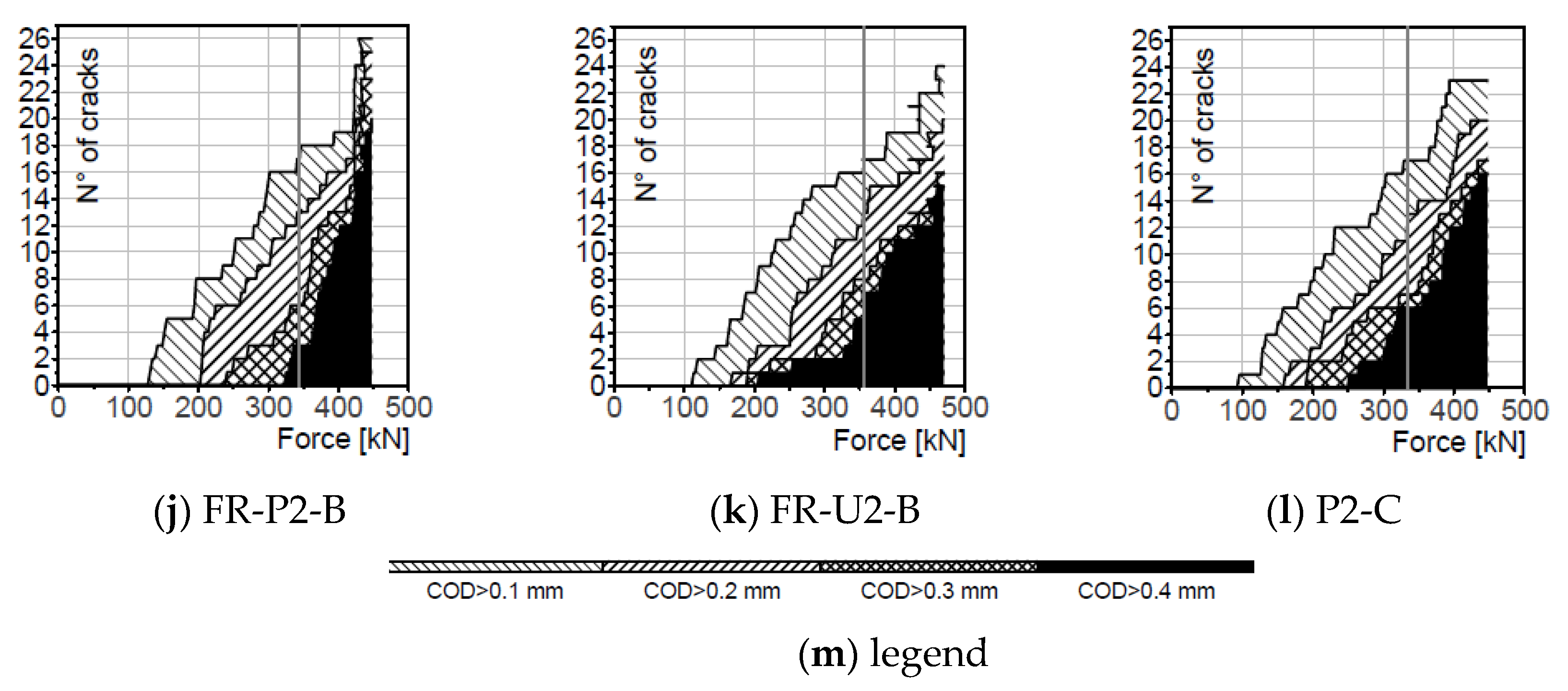

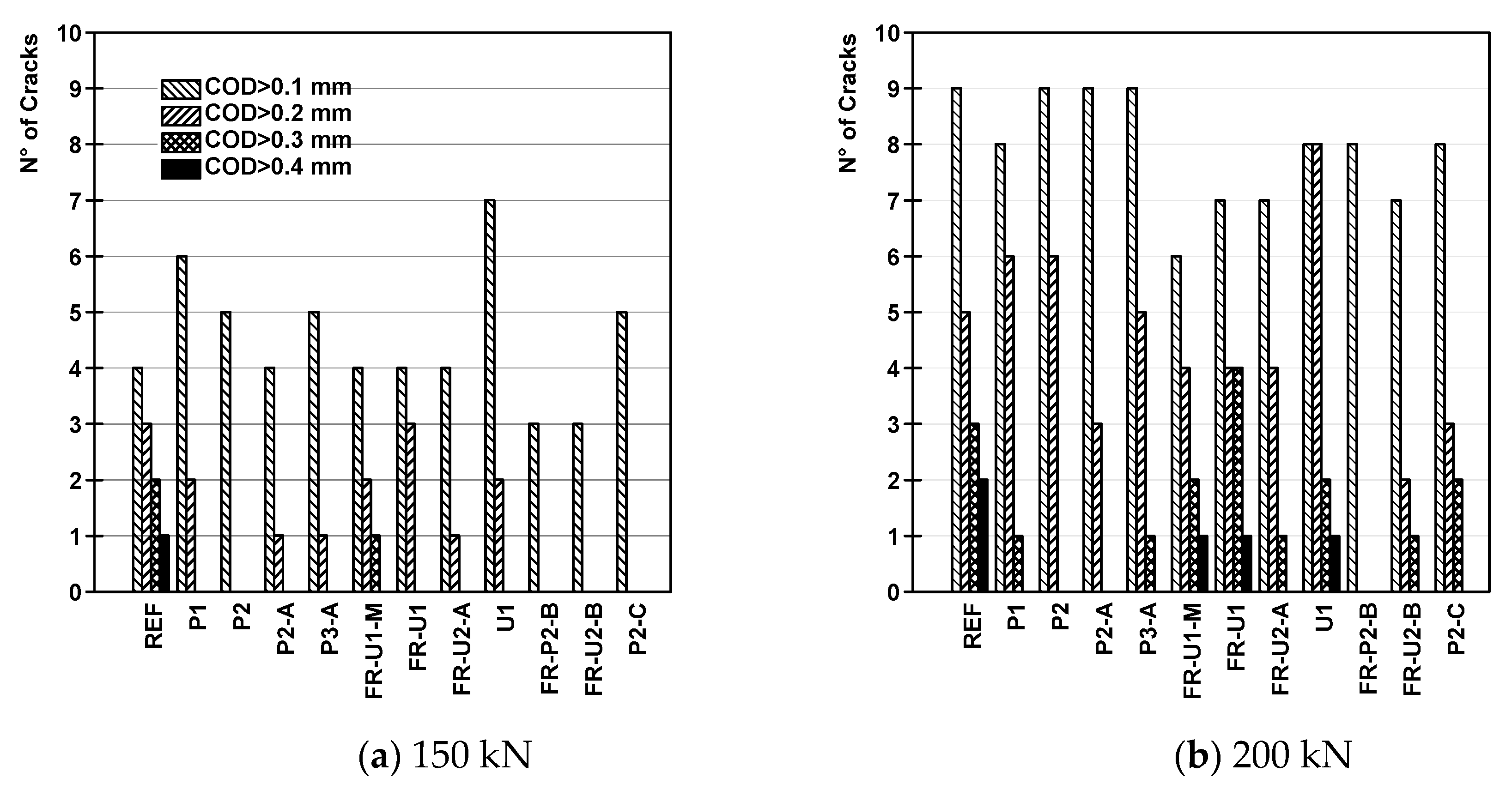
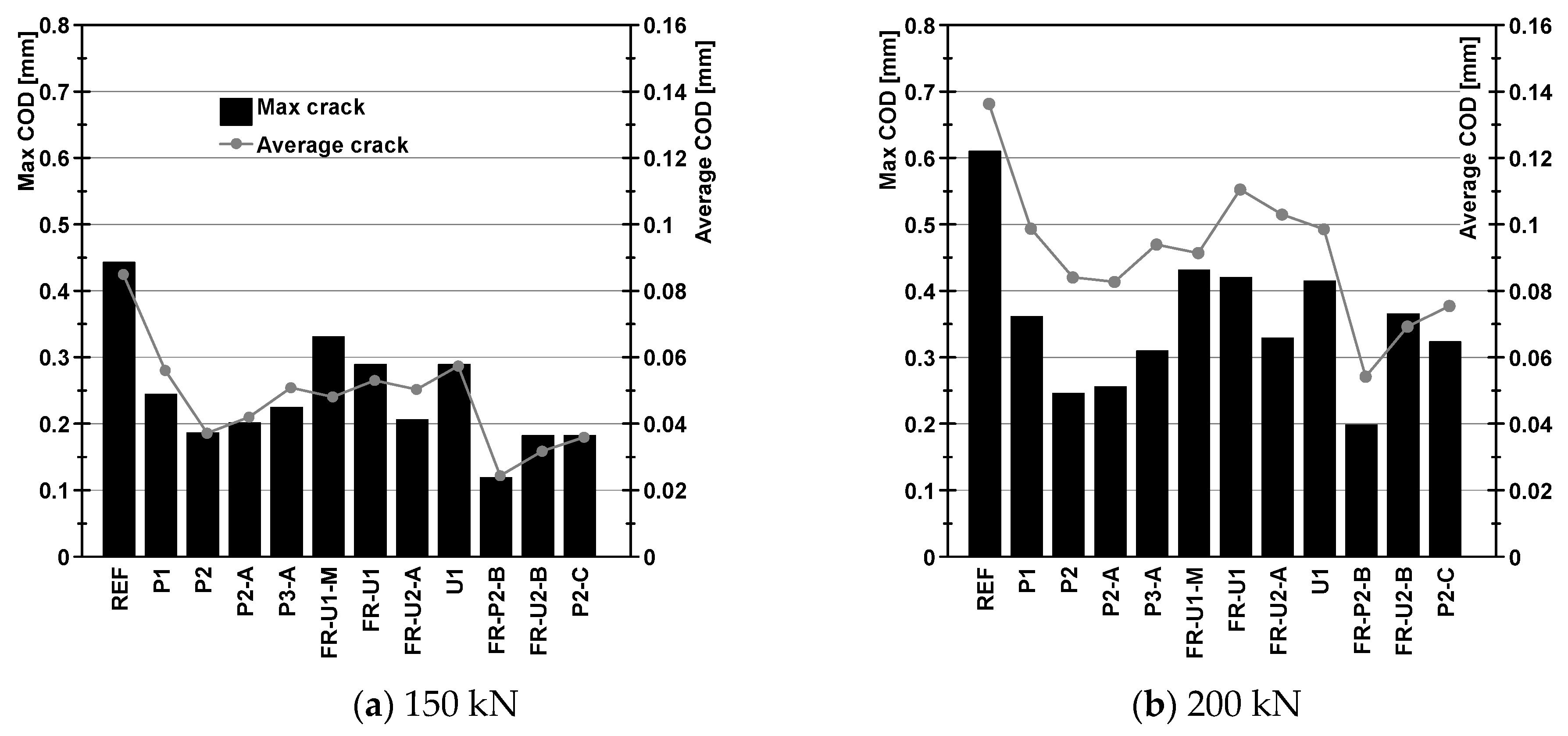
| Specimen ID | Casting Method * | N° of Layers/Anchorage | Cementitious Matrix | Compressive Strength [MPa] | Tensile Strength [MPa] |
|---|---|---|---|---|---|
| REF1 | – | – | – | 55.2 | – |
| P1 | L | 1/– | HPC | 88.7 | 4.8 |
| P2 | L | 2/– | HPC | 81.9 | 4.8 |
| P2-A | L | 2/A | HPC | 80.8 | 5.9 |
| P3-A | L | 3/A | HPC | 92.7 | 6.6 |
| FR-U1-M | M | 1/– | UHPFRC | 169 | 13.0 |
| FR-U1 | P | 1/– | UHPFRC | 159.2 | 11.8 |
| FR-U2-A | P | 2/A | UHPFRC | 146.4 | 13.3 |
| U1 | P | 1/– | UHPC | 184.4 | 5.2 |
| FR-P2-B | L | 2/B | HPFRC | 89.7 | 9.3 |
| FR-U2-B | P | 2/B | UHPFRC | 184.1 | 14.3 |
| P2-C | L | 2/C | HPC | 88.8 | 3.3 |
| REF2 | – | – | – | 59.1 | – |
| Specimen ID | Cracking Load (kN) 1 | Yielding Load (kN) | Maximum Load (kN) | Peak Load Increase (%) | Failure Mode |
|---|---|---|---|---|---|
| REF-1 | 73.66 | 275.78 | 316.87 | – | |
| P1 | 92.62 | 297.79 | 337.68 | 6.29 | d |
| P2 | 99.08 | 324.08 | 367.95 | 15.81 | d/e |
| P2-A | 91.76 | 321.90 | 387.71 | 22.03 | d/e |
| P3-A | 90.53 | 357.15 | 416.94 | 31.23 | d/e |
| FR-U1-M | 93.64 | 317.67 | 370.41 | 16.59 | c |
| FR-U1 | 93.27 | 316.56 | 370.46 | 16.61 | a |
| FR-U2-A | 117.66 | 342.36 | 370.35 | 16.57 | e |
| U1 | 84.97 | 304.87 | 362.13 | 13.98 | a/d |
| FR-P2-B | 131.01 | 342.86 | 447.10 | 40.73 | b/d |
| FR-U2-B | 113.65 | 356.74 | 470.24 | 48.01 | b/c |
| P2-C | 95.80 | 334.57 | 447.28 | 40.78 | b/d |
| REF-2 | – | 274.53 | 318.54 | – |
| Beam ID | Load at Crack Opening (kN) | Load Increase (%) | ||||||
|---|---|---|---|---|---|---|---|---|
| 0.1 mm | 0.2 mm | 0.3 mm | 0.4 mm | 0.1 mm | 0.2 mm | 0.3 mm | 0.4 mm | |
| REF-1 | 73.66 | 100.54 | 121.69 | 143.12 | – | – | – | – |
| P1 | 92.62 | 145.92 | 171.80 | 222.00 | 25.7 | 45.1 | 41.2 | 55.1 |
| P2 | 99.08 | 163.21 | 222.10 | 271.80 | 34.5 | 62.3 | 82.5 | 89.9 |
| P2-A | 91.76 | 151.49 | 245.6 | 302.87 | 24.6 | 50.7 | 101.8 | 111.6 |
| P3-A | 90.53 | 134.95 | 191.94 | 244.88 | 22.9 | 34.2 | 57.7 | 71.1 |
| FR-U1-M | 93.64 | 111.67 | 131.83 | 185.12 | 27.1 | 11.1 | 8.3 | 29.3 |
| FR-U1 | 93.27 | 126.21 | 151.57 | 183.52 | 26.6 | 25.5 | 24.6 | 28.2 |
| FR-U2-A | 117.66 | 150.25 | 191.99 | 232.65 | 59.7 | 49.4 | 57.8 | 62.6 |
| U1 | 84.97 | 123.40 | 151.68 | 195.27 | 15.4 | 22.7 | 24.6 | 36.4 |
| FR-P2-B | 131.01 | 204.07 | 240.89 | 325.05 | 77.9 | 103.0 | 98.0 | 127.1 |
| FR-U2-B | 113.65 | 169.20 | 190.67 | 206.83 | 54.3 | 68.3 | 56.7 | 44.5 |
| P2-C | 95.80 | 160.92 | 192.00 | 252.06 | 30.1 | 60.1 | 57.8 | 76.1 |
Publisher’s Note: MDPI stays neutral with regard to jurisdictional claims in published maps and institutional affiliations. |
© 2021 by the authors. Licensee MDPI, Basel, Switzerland. This article is an open access article distributed under the terms and conditions of the Creative Commons Attribution (CC BY) license (https://creativecommons.org/licenses/by/4.0/).
Share and Cite
Rossi, E.; Randl, N.; Mészöly, T.; Harsányi, P. Effect of TRC and F/TRC Strengthening on the Cracking Behaviour of RC Beams in Bending. Materials 2021, 14, 4863. https://doi.org/10.3390/ma14174863
Rossi E, Randl N, Mészöly T, Harsányi P. Effect of TRC and F/TRC Strengthening on the Cracking Behaviour of RC Beams in Bending. Materials. 2021; 14(17):4863. https://doi.org/10.3390/ma14174863
Chicago/Turabian StyleRossi, Edoardo, Norbert Randl, Tamás Mészöly, and Peter Harsányi. 2021. "Effect of TRC and F/TRC Strengthening on the Cracking Behaviour of RC Beams in Bending" Materials 14, no. 17: 4863. https://doi.org/10.3390/ma14174863
APA StyleRossi, E., Randl, N., Mészöly, T., & Harsányi, P. (2021). Effect of TRC and F/TRC Strengthening on the Cracking Behaviour of RC Beams in Bending. Materials, 14(17), 4863. https://doi.org/10.3390/ma14174863






